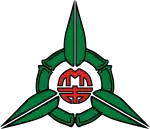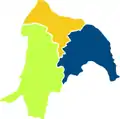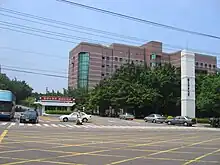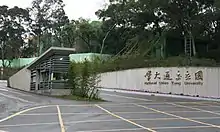Hsinchu
Hsinchu[upper-roman 1] (/ˈʃɪnˈdʒuː/,[3] Chinese: 新竹, Pinyin: Xīnzhú, Wade–Giles: Hsin¹-chu²) is a city located in northwestern Taiwan. It is the most populous city in Taiwan that is not a special municipality, with estimated 450,655 inhabitants.[4] Hsinchu is a coastal city bordering the Taiwan Strait to the west, Hsinchu County to the north and east, and Miaoli County to the south. Nicknamed the Windy City for its strong northeastern monsoon during the autumn and winter seasons.[5]
Hsinchu
| |
|---|---|
| Hsinchu City | |
 | |
 Flag  Logo | |
| Nickname: City of wind (風城) | |
 Hsinchu Location within Taiwan | |
| Coordinates: 24°49′N 120°59′E | |
| Country | |
| Region | Northern Taiwan |
| Seat | North District |
| Districts | |
| Government | |
| • Body | |
| • Mayor | Ann Kao (TPP) |
| Area | |
| • Total | 104.15 km2 (40.21 sq mi) |
| • Rank | 20 out of 22 |
| Population (March 2023)[2] | |
| • Total | 453,536 |
| • Rank | 15 of 22 |
| • Density | 4,400/km2 (11,000/sq mi) |
| Time zone | UTC+8 (National Standard Time) |
| Postal code | 300 |
| Area code | (0)3 |
| ISO 3166 code | TW-HSZ |
| Bird | Eurasian magpie (Pica pica) |
| Flower | Azalea |
| Website | www |
| Hsinchu | |||||||||||||||||||||||||||||||
|---|---|---|---|---|---|---|---|---|---|---|---|---|---|---|---|---|---|---|---|---|---|---|---|---|---|---|---|---|---|---|---|
| Chinese name | |||||||||||||||||||||||||||||||
| Chinese | 新竹 | ||||||||||||||||||||||||||||||
| |||||||||||||||||||||||||||||||
| Japanese name | |||||||||||||||||||||||||||||||
| Kanji | 新竹 | ||||||||||||||||||||||||||||||
| Kana | しんちく | ||||||||||||||||||||||||||||||
| |||||||||||||||||||||||||||||||
| Former names | |||||||||||||
|---|---|---|---|---|---|---|---|---|---|---|---|---|---|
| Zhuqian | |||||||||||||
| Traditional Chinese | 竹塹 | ||||||||||||
| Literal meaning | Bamboo Barrier | ||||||||||||
| |||||||||||||
| Nicknames | |||||||||||||||||||
|---|---|---|---|---|---|---|---|---|---|---|---|---|---|---|---|---|---|---|---|
| Windy City | |||||||||||||||||||
| Traditional Chinese | 風城 | ||||||||||||||||||
| |||||||||||||||||||
The area was originally settled by the Austronesian Taiwanese indigenous peoples, with the settlement being named "Tek-kham" by the Hoklo immigrants. The city was founded by Han Chinese settlers in 1711, and renamed as Hsinchu in 1878. During the Japanese Era, the city was the seat of Shinchiku Prefecture, named after the city. The prefecture encompassed present-day Hsinchu City and County, as well as entire Taoyuan and Miaoli. After the ROC rule in 1945, the urban area of Hsinchu was organized as a provincial city.
In 1980, the Taiwanese government established the Hsinchu Science Park, a major industrial park, a significant centre for semiconductor manufacturing, industrial and computer technology development. The park contributes a major proportion of Taiwan's GDP. This made Hsinchu a vital economic hub for its economy; the headquarters of TSMC, world's largest independent semiconductor foundry, MediaTek and United Microelectronics Corporation, are both located in the park.
Besides its industry, Hsinchu is also an important cultural center of Taiwan with an abundance of heritage sites.[6] The Chenghuang Temple of Hsinchu, built in 1747, is a common prayer destination. The research institutions of National Yang Ming Chiao Tung University and National Tsing Hua University are both located near the science park.
Etymology
Hsin-chu is the Wade-Giles romanization of the Mandarin pronunciation of the Chinese name 新竹. The same name is rendered Xīnzhú in Hanyu Pinyin and Sinjhú in Tongyong Pinyin.
This name refers to the settlement's original Hokkien name Tek-chhàm (竹塹),[7] meaning "bamboo barrier".[8] The name may transcribe an aboriginal name meaning "Seashore". The same name is variously recorded as Teukcham,[9] Teuxham,[9] Tekcham,[10] and Teckcham;[11] its Mandarin pronunciation appears as Chuchien.[8]
Hsinchu is popularly nicknamed "The Windy City" for its windy climate[12] and "The Garden City of Culture and Technology" by its tourism department.[8]
History
Early settlement
The area around Hsinchu City was inhabited by the Taokas aboriginies[13] when the Spanish occupied northern Taiwan in the 17th century. Catholic missionaries reached the settlement of Tek-kham in 1626. The Spanish were expelled by the Dutch a few decades later.
Qing Dynasty
Under the Qing, a Chinese town was established at Tek-kham by Wang Shih-chieh and other Han settlers in 1711.[8] Wang and his party of over 180 people were natives of Kinmen who first camped alongside what is now Dongqian Street in East District, Hsinchu.[14]
As part of the reorganization of Taiwan by Shen Baozhen, the viceroy of Liangjiang, Zhuqian Subprefecture (i.e., Tek-kham) was raised to the level of a county and renamed Xinzhu (i.e., Sin-tek or Hsinchu) in 1878.[15] When Taiwan was made a province in 1887, Hsinchu was made a part of Taipeh Prefecture.
Japanese rule

During the Japanese occupation following the First Sino-Japanese War, the city—known at the time as Shinchiku—was among the province's most populous. In 1904, its 16,371 residents ranked it in 7th place, behind Keelung and ahead of Changhua ("Shoka"). Shinchiku was raised to town status in 1920 and city status in 1930. At the same time, it became the seat of Shinchiku Prefecture. In 1941, its prefecture was expanded, annexing Xiangshan ("Kōzan"). Jiugang ("Kyūminato") and Liujia ("Rokka") merged to become Zhubei ("Chikuhoku").
Republic of China
The Nationalist government of the Republic of China established the Hsinchu City Government in 1945 to oversee all of what had been Shinchiku Prefecture under the Japanese.
In 1946, the Take-Over Committee dissolved and replaced by the Hsinchu County Government, located in Taoyuan. As the administrative districts were readjusted, Hsinchu was granted provincial city status. It used the old prefecture office as its city hall at 120 Chung Cheng Road. In February 1946, representative congresses were formed for seven district offices. On 15 April, the city congress was formed. Provincial representatives were elected from among the city legislators.
On 16 August 1950, the administrative districts on Taiwan were re-adjusted once more, demarcating 16 counties and 5 provincial cities.
In June 1982, under presidential order, the Xiangshan Township of Hsinchu County merged into Hsinchu City. A new municipal government was formally established on 1 July 1982, comprising 103 villages and 1,635 neighborhoods. These were organized into the East, North, and Xiangshan districts by 1 November.[16] By June 1983, the new government consisted of three bureaus (Civil Service, Public Works, and Education), four departments (Finance, Social Welfare, Compulsory Military Service, and Land Affairs), four offices (Secretary, Planning, Personnel, and Auditing), and 49 various sections. The Police Department, Tax Department, and Medicine and Hygiene Department were considered affiliate institutions.
From 1994 to 1999, as Taiwan made its transition from authoritarian rule to a representative democracy and the mostly pro forma provincial level of government began to be dissolved, regulations were established for the self-government of Hsinchu. A deputy mayor, consumer officer, and three consultants were added to the city government. In 2002, the city added a Bureau of Labor and transferred Compulsory Military Service to the Department of Civil Service.
A movement is underway from 2021 to have Hsinchu City and Hsinchu County to be upgraded to the nation's seventh special municipality.[17]
Geography
The city is bordered by Hsinchu County to the north and east, Miaoli County to the south, and the Taiwan Strait to the west.
Climate
Hsinchu's climate is humid subtropical (Koppen: Cfa). The city is located in a part of the island that has a rainy season that lasts from February to September, with the heaviest time coming late April through August during the southwest monsoon, and also experiences heavy "plum rains" in May and early June.[18] The city succumbs to hot humid weather from June until September, while October to December are arguably the most pleasant times of year. Hsinchu is affected by easterly winds off of the East China Sea. Natural hazards such as typhoons and earthquakes are common in the region.[19][20][21]
| Climate data for Hsinchu City (1991–2020 normals, extremes 1938–present) | |||||||||||||
|---|---|---|---|---|---|---|---|---|---|---|---|---|---|
| Month | Jan | Feb | Mar | Apr | May | Jun | Jul | Aug | Sep | Oct | Nov | Dec | Year |
| Record high °C (°F) | 30.3 (86.5) |
30.6 (87.1) |
33.8 (92.8) |
34.1 (93.4) |
35.5 (95.9) |
37.4 (99.3) |
38.0 (100.4) |
39.4 (102.9) |
38.8 (101.8) |
37.9 (100.2) |
34.4 (93.9) |
31.1 (88.0) |
39.4 (102.9) |
| Average high °C (°F) | 19.1 (66.4) |
19.4 (66.9) |
21.6 (70.9) |
25.6 (78.1) |
28.9 (84.0) |
31.5 (88.7) |
33.2 (91.8) |
32.8 (91.0) |
31.2 (88.2) |
28.0 (82.4) |
25.1 (77.2) |
21.1 (70.0) |
26.5 (79.6) |
| Daily mean °C (°F) | 15.7 (60.3) |
16.0 (60.8) |
18.0 (64.4) |
21.9 (71.4) |
25.2 (77.4) |
27.9 (82.2) |
29.3 (84.7) |
28.9 (84.0) |
27.3 (81.1) |
24.4 (75.9) |
21.5 (70.7) |
17.7 (63.9) |
22.8 (73.1) |
| Average low °C (°F) | 13.1 (55.6) |
13.4 (56.1) |
15.2 (59.4) |
18.9 (66.0) |
22.2 (72.0) |
24.9 (76.8) |
26.0 (78.8) |
25.8 (78.4) |
24.4 (75.9) |
21.8 (71.2) |
18.8 (65.8) |
15.1 (59.2) |
20 (68) |
| Record low °C (°F) | −0.1 (31.8) |
3.5 (38.3) |
3.4 (38.1) |
4.9 (40.8) |
11.7 (53.1) |
14.7 (58.5) |
20.2 (68.4) |
18.9 (66.0) |
14.7 (58.5) |
9.5 (49.1) |
6.6 (43.9) |
4.0 (39.2) |
−0.1 (31.8) |
| Average precipitation mm (inches) | 75.7 (2.98) |
123.0 (4.84) |
159.8 (6.29) |
161.9 (6.37) |
249.0 (9.80) |
252.0 (9.92) |
120.2 (4.73) |
197.1 (7.76) |
174.5 (6.87) |
53.6 (2.11) |
51.1 (2.01) |
57.7 (2.27) |
1,675.6 (65.95) |
| Average precipitation days (≥ 0.1 mm) | 9.8 | 11.3 | 13.5 | 12.7 | 12.0 | 10.6 | 7.9 | 10.7 | 8.9 | 5.5 | 6.8 | 8.0 | 117.7 |
| Average relative humidity (%) | 78.3 | 80.4 | 79.6 | 78.4 | 78.1 | 77.0 | 74.3 | 75.9 | 74.5 | 73.8 | 75.5 | 76.3 | 76.8 |
| Mean monthly sunshine hours | 106.7 | 91.0 | 101.0 | 111.6 | 145.4 | 185.0 | 240.6 | 209.7 | 193.5 | 190.0 | 144.8 | 126.1 | 1,845.4 |
| Source: Central Weather Bureau[22][23][24][25][26] | |||||||||||||
Government

| Year | Pop. | ±% |
|---|---|---|
| 1985 | 304,010 | — |
| 1990 | 324,426 | +6.7% |
| 1995 | 340,255 | +4.9% |
| 2000 | 368,439 | +8.3% |
| 2005 | 394,757 | +7.1% |
| 2010 | 415,344 | +5.2% |
| 2015 | 434,060 | +4.5% |
| 2020 | 451,412 | +4.0% |
| Source:"Populations by city and country in Taiwan". Ministry of the Interior Population Census. May 2018. | ||
Hsinchu City is administered as a city. North District is the seat of Hsinchu City which houses the Hsinchu City Government and Hsinchu City Council. The incumbent Mayor of Hsinchu City is Ann Kao Hung-an of the Taiwan People's Party.
Administrative divisions
Hsinchu has 3 districts (區):[27][28]
| Map | Name | Chinese | Hokkien | Hakka | Population (March 2023) | Area (km²) | |
|---|---|---|---|---|---|---|---|
 |
East | 東區 | Tang | Tûng | 222,223 | 33.5768 | |
| North | 北區 | Pak | Pet | 152,504 | 15.7267 | ||
| Xiangshan | 香山區 | Hiong-san | Hiông-sân | 78,809 | 54.8491 | ||
Colors indicate the common language status of Hakka within each division.
Politics
Hsinchu City voted one Kuomintang legislator to be in the Legislative Yuan during the 2020 Taiwan general election.
The city was historically pan-Blue, but in recent years the pan-Green coalition has started to rise in popularity. In addition, the economic development and urbanization in the city has caused an influx of a highly-educated population. As a result, local factions have decreased in power, and political parties have a greater importance in local elections.[29]
Economy
The Hsinchu Science Park is home to 360 high tech companies. As a result, the city has the highest income level in Taiwan.[30]
The purpose of the park is to attract high tech investment to Taiwan and to make the area the economic center for the information industry. The park is designed to cater for high quality R&D, production, work, life and also recreation. From its establishment in 1978, the government has invested over NT$30 billion on software and hardware ventures. In 2001, it developed 2.5 km2 (0.97 sq mi) of land in the park and 0.5 km2 (0.19 sq mi) in southern Hsinchu, attracting 312 high-tech companies' investments. Viewing the performance of Hsinchu Science Park in the past 21 years, it can be said that it holds a decisive position in the economic development in Taiwan, with international acclaim.
Although the semiconductor and related electronic businesses have been doing well, they face fierce competition from South Korea and the United States. This has resulted in lower profits and over-supply of some electronic products such as memory and semiconductors. Therefore, manufacturers, government, academia, and the R&D sectors all recognize the challenges faced by Taiwan's high-tech development. The government has endeavored to upgrade Hsinchu Science Park into a global manufacturing and R&D center of high-end products. They also plan to intensify the cooperation among the manufacturing, academic, and research sectors by introducing incubation centers, in order to elevate the technological standard in the park. Further, through the development of the northern, central, and southern industrial park and its satellite sites, it hopes to sow the seeds of high tech business in all of Taiwan, leading to a vigorous era of high tech development.
In 2020, Hsinchu is classified as a "Sufficiency" level global city by the Globalization and World Cities Research Network.[31]
Education


Hsinchu City is one of the most focused educational centers in northern Taiwan. It has six universities in this concentrated area and among these universities, National Yang Ming Chiao Tung University and National Tsing Hua University are highly focused by government in Taiwan on its academic development. Other public and private educational institutions in the city included 33 elementary schools, 19 middle schools, 12 high school and complete secondary school.
International schools (grade school and secondary school)
- Pacific American School[32]
- Hsinchu International School[33]
- Hsinchu American School[34]
High Schools
- National Experimental High School
- National Hsinchu Senior High School
- National Hsinchu Girls' Senior High School
- National Hsinchu Commercial Vocational High School
- National Hsinchu Senior Industrial Vocational School
- Hsinchu Municipal Chien Kung Senior High School
- Hsinchu Municipal Cheng Te Senior High School
- Hsinchu Municipal Hsiang Shan Senior High School
- Hsinchu Shu Guang Girls' Senior High School
- Hsinchu World Senior High School
- Hsinchu St. Peter High School
- Hsinchu Kuang-Fu Senior High School
Universities
Tourist attractions
- Aqueduct Museum of Hsinchu City
- Black Bat Squadron Memorial Hall
- Chenghuang Temple of Hsinchu
- Glass Museum of Hsinchu City
- Hsinchu City Art Site of Railway Warehouse
- Hsinchu CKS Baseball Stadium
- Hsinchu Museum of Military Dependents Village
- Hsinchu Fish Harbor
- Hsinchu Zoo
- National Hsinchu Living Arts Center
- 17 Kilometer Coastal Scenic Area[35]
- Eighteen Peaks Mountain Park
- Hsinchu Eastern Gate
- Chenghuang Temple Night Market
- Tsing Hua Night Market
- Green Grass Lake
| Name | Feature | Location |
|---|---|---|
| Chenghuang Temple Night Market | Most of the old stands in Cheng-huang Temple are of 50-year-old history, the famous snacks here are Hsin-chu meat balls, pork balls, spring rolls, braised pork rice, cuttlefish thick soup, rice noodles, and cow tongue shaped cakes (quote from Tourism Bureau, MOTC, T.O.C.[36]) | Cheng-huang Temple and fa-lian shrine square |
| Neiwan Old Street | Traditional Hakka restaurants and shops serve ginger lily-flavored glutinous rice dumplings, Hakka tea, and Hakka rice cakes.[37] | Hengshan Town |
Sports
Taiwan's Chinese Professional Baseball League has a professional baseball team, Wei Chuan Dragons, based in Hsinchu.[38]
Major sporting events held by Hsinchu include:
- 1997 World Youth Baseball Championship
- 2005 BWF Para-Badminton World Championships
Transportation

Rail
Hsinchu City is mainly served by Hsinchu railway station along with five other minor TRA stations on both Western Trunk line and Neiwan line. There is also an HSR station in nearby Zhubei, Hsinchu County on Taiwan High Speed Rail.
Cycling
Hsinchu City has recently created a series of cycling routes to help cyclists navigate the city more easily. Hsinchu is home to many cycling clubs.
Sea ports
Pleasure and fishing ports are located at Nanliao Street, North District and in Haishan, Xiangshan district.
Airport
Hsinchu Airport is located in North District mainly used as a military airbase. The nearest international airport is Taoyuan International Airport which is located 58 km away from the city.
Notable natives
- Chi Cheng, the 1968 Olympic bronze medalist in track and field
- Yuan T. Lee, 1986 Nobel Laureate in Chemistry
- Chiang Hsiao-yen, Vice Premier (1997)
- Lin Cho-liang, Taiwanese American violinist
- Hsieh Su-Wei, Taiwanese tennis player and former World No. 1 in doubles
- Hebe Tien, solo artist and member of the S.H.E
- David Wu, member of the U.S. House of Representatives for the state of Oregon from 1999 until 2011.
- Cyndi Wang, singer
- Chen Qiaoen, singer, actress, 7F Member
- Lü Shao-chia, Taiwanese conductor
- Wen Shang-Yi, guitarist and leader of the band Mayday
International relations
Twin towns — sister cities
| City | Region | Country | Since |
|---|---|---|---|
| Beaverton | Oregon | 1988 | |
| Cary | North Carolina | 1993 | |
| Cupertino | California | 1998 | |
| Richland | Washington | 1988 | |
| Plano | Texas | 2003 | |
| Okayama | Okayama Prefecture | 2003 | |
| Puerto Princesa | Palawan | 2006 | |
| Fairfield | New South Wales | 1994 | |
| Chiayi City | Taiwan | 2002 | |
| Airai | Airai | 2011 |
Notes
References
- 《中華民國統計資訊網》縣市重要統計指標查詢系統網 (in Chinese). Archived from the original on 12 June 2016. Retrieved 9 July 2016.
- 新竹市統計月報 (in Chinese (Taiwan)). Hsinchu City Government. Retrieved 9 July 2016.
- "Xinzhu". Merriam-Webster.com Dictionary.
- 中華民國內政部戶政司 (1 May 2018). "中華民國 內政部戶政司 全球資訊網". 中華民國內政部戶政司. Retrieved 29 April 2020.
- "Natural climate". Hsinchu City Government. Retrieved 4 November 2022.
- Kelly Her (1 July 2019). "Taiwan Review-Culturally Connected". Taiwan Today. Retrieved 3 March 2023.
- "竹塹 Tik-tshàm". 臺灣閩南語常用詞辭典 (in Chinese). Ministry of Education, R.O.C. 2011. Retrieved 13 November 2020.
- Wang, Erika (25 October 2007), "Hsinchu Owns Rich History, Culture, and Natural Resources", China Post, Taipei: China Post, archived from the original on 30 October 2013, retrieved 7 December 2019.
- . . 1879 – via Wikisource.
- Page 7, Report for the Year 1898 on the Trade of North Formosa (Her Majesty’s Stationery Office, Her Britannic Majesty’s Government, 1899)
- Page 180, The Island of Formosa: Past and Present (Macmillan & Co., 1903)
- "Hsinchu Taiwan – The Windy City of Food and Fun". Asian Wanderlust. 28 October 2018. Retrieved 9 June 2022.
- "History of Hsinchu". TravelTill. Retrieved 9 June 2022.
- Han Cheung (2 October 2022). "Taiwan in Times: Hsinchu's first Han settler". Taipei Times. Retrieved 2 October 2022.
- Davidson, James W. (1903), The Island of Formosa, Past and Present: History, People, Resources, and Commercial Prospects: Tea, Camphor, Sugar, Gold, Coal, Sulphur, Economical Plants, and Other Productions, London: Macmillan, p. 211, OCLC 1887893, OL 6931635M, archived from the original on 8 January 2015, retrieved 12 June 2016.
- "Rezoning Taiwan". Taiwan Today. 1 February 2011. Retrieved 9 December 2020.
- "Amendment paving way for Hsinchu city-county merger clears first hurdle - Focus Taiwan".
- "Monthly Mean Days of Precipitation". Climate Data. ROC Central Weather Bureau. Archived from the original on 3 December 2005. Retrieved 8 March 2006.
- "Rescuers hunt quake survivors". BBC. 21 September 1999. Archived from the original on 2 April 2019. Retrieved 31 March 2008.
- "Recent Earthquakes Near Hsinchu, Taiwan, Taiwan". Archived from the original on 20 July 2016. Retrieved 4 July 2017.
- "Earthquakes Today". Archived from the original on 2 May 2016. Retrieved 4 July 2017.
- "Monthly Mean". Central Weather Bureau. Retrieved 29 November 2022.
- "氣象站各月份最高氣溫統計" (PDF) (in Chinese). Central Weather Bureau. Retrieved 29 November 2022.
- "氣象站各月份最高氣溫統計(續)" (PDF) (in Chinese). Central Weather Bureau. Retrieved 29 November 2022.
- "氣象站各月份最低氣溫統計" (PDF) (in Chinese). Central Weather Bureau. Retrieved 29 November 2022.
- "氣象站各月份最低氣溫統計(續)" (PDF) (in Chinese). Central Weather Bureau. Retrieved 29 November 2022.
- 臺灣地區鄉鎮市區級以上行政區域名稱中英對照表 (PDF). Online Translation System of Geographic Name, Ministry of Interior. 16 June 2011. p. 13. Archived from the original (PDF) on 25 March 2012.
- "Geographic location". Hsinchu City Government. 22 January 2016. Archived from the original on 21 October 2016. Retrieved 7 June 2019.
- 林, 清察 (15 May 2006). 台灣與大陸政治評論集 (in Chinese (Taiwan)). 秀威資訊.
- "Hsinchu highest salary in Taiwan, Taichung lo..." Taiwan News. 10 May 2017. Archived from the original on 6 March 2019. Retrieved 2 March 2019.
- "The World According to GaWC 2020". GaWC - Research Network. Globalization and World Cities. Retrieved 31 August 2020.
- "Pacific American School". www.pacificamerican.org. Archived from the original on 30 June 2019. Retrieved 7 December 2019.
- "Hsinchu International School". hc.edu.tw. Archived from the original on 9 May 2019. Retrieved 7 December 2019.
- "Hsinchu American School". hc.edu.tw. Archived from the original on 21 December 2007. Retrieved 9 January 2008.
- "Theme Tours - Department of Tourism Hsinchu City Government". hccg.gov.tw. Archived from the original on 4 October 2015. Retrieved 9 June 2015.
- "Eng.taiwan.net.tw". taiwan.net.tw. Archived from the original on 16 June 2008. Retrieved 21 May 2008.
- "Neiwan Old Street travel guide of hot destinations (Sinotour)–Taiwan travel hotels,Hsinchu County tourism,Neiwan Old Street". Archived from the original on 5 November 2013. Retrieved 5 November 2013.
- "Dragons". CPBL. Chinese Professional Baseball League. Retrieved 1 January 2023.
- "Sister Cities". Hsinchu City Government. Archived from the original on 15 February 2015. Retrieved 15 February 2015.




